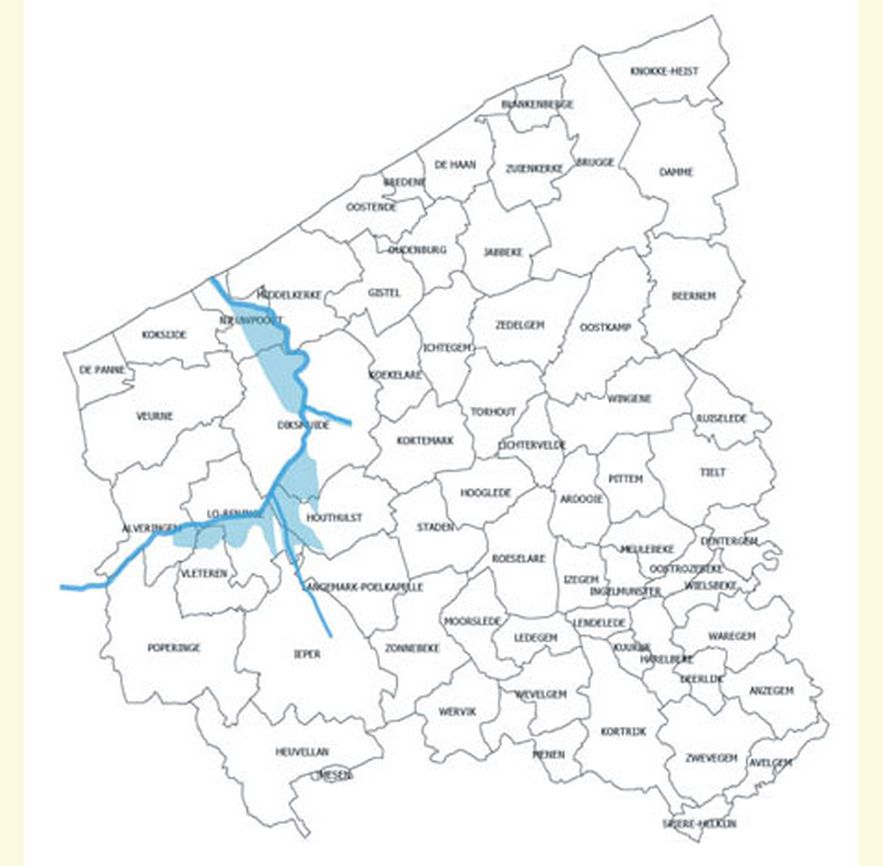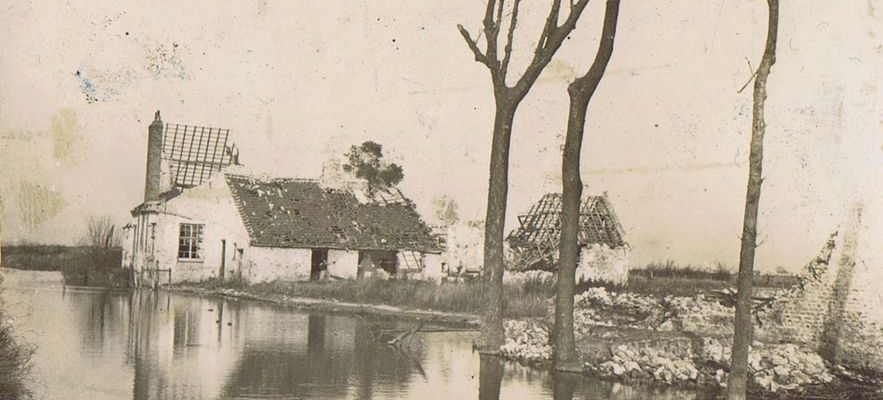While the destruction of the Kakhovka dam on the Dnieper floods and ravages the Kherson region – causing the exodus of thousands of Ukrainian civilians, deaths, and considerable environmental damage – there is a place, a quarter of hour’s drive from France, where this episode brings back historical memories. It is Diksmuide, in Belgium, where, 20 kilometers from the French border, the army of Marshal Joffre managed, in October 1914, to stop the advance of the German army by opening the floodgates of the Nieuport lock to flood the Yser plain.
Defensive flood after the Battle of the Yser (Belgium) in 1914
© / Aan de Ijzer Museum (Diksmuide)
2,000 kilometers away and 109 years apart, this episode is reminiscent – through its impact on the course of the war – of the blasting of the dam on the Dnieper by Putin’s army. But with two differences: France had not invaded Belgium and the hairy people had not committed any war crimes, contrary to what the roughnecks of Putin’s army have been practicing daily since February 24, 2022.
Curator of the formidable Yser Tower museum (a “must” for anyone interested in the 1914-1918 war) in Diksmuide, Belgium, Peter Verplancke returns, for L’Express, to this event which marked a turning point in the Great War: “By freezing the front, he said, the mega flooding of the Yser plain put an end to the war of movements to open the long sequence of trench warfare.”
For four years, a simple embankment of 1.20 meters, where the railway passes, protects the French side from flooding after the battle of the Yser
© / Aan de Ijzer Museum (Diksmuide)
We are therefore in October 1914, inside the kingdom of Belgium, halfway between Dunkirk and Ostend. Three months after the outbreak of hostilities, King Albert resolved to retreat towards France after having tried in vain to defend Liège, Namur and Antwerp. “It was the best option because if he had gone to Holland, he would have been surrounded a few days later,” recalls Peter Verplancke.
“Race to the sea” stopped
Withdrawn to Diksmuide, very close to the border, the Belgians immediately established contact with the French troops. On site are already Admiral Ronarc’h marine riflemen sent as reinforcements from Brest. “From October 13 and 14, the King of the Belgians hopes to hold a defensive line along the very modest River Yser.” On the 17th, the fierce and heroic battle of Diksmuide (won by the Germans) begins.
The fights are grueling. The Germans, numbering around 50,000, are five times more numerous than the Belgians (5,000 soldiers) and the French (6,600). Despite enormous human sacrifices, on the Allied side, the Germans conquered Diksmuide in ruins and crossed the Yser. With the reinforcement of 1,200 Senegalese skirmishers, Belgians and French fell back behind the railway line which was King Albert I’s last line of defense in Belgium. The fighting continued: in total, 8,000 Germans, 1,250 Belgians, as well as 1 out of 2 Frenchmen and 60% of the Senegalese skirmishers, perished in what was one of the very first “butcheries” of the Great War.

Footbridge over the flooded plain of the Yser, Belgium, in 1916, after the Battle of the Yser
© / Aan de Ijzer Museum (Diksmuide)
On October 28 and 29, the army of Kaiser Wilhelm II progressed further and conquered two localities. The way to Dunkirk and Calais seems open to the Germans but their “race to the sea” is stopped by a daring defensive maneuver. Two days earlier, the French command opened the gates of the Nieuport lock (located further north) as well as several others placed at different points in the hydraulic network of the agricultural plain of the Yser, crossed by a multitude of streams – all below sea level.
In a few days the polder was flooded over a length of 15 kilometers and a width ranging from 400 to 1,500 meters. Apart from the vanguard of the Germanic army, which had already crossed the Yser, the 4th German Army was stopped dead in its progression, which however seemed inexorable.
“The German command then decided to play the card of patience while waiting for the water to penetrate the ground and evaporate, continues the curator Peter Verplancke. It is not so. Thanks to the knowledge of the lock keepers and the peasants locals who adjusted the floodgates to the nearest centimeter, the plain remained impracticable for four years, flooded to a height of 1.20 meters.Surrounded by water or slush, depending on the slope of the ground, all the flooded farms remained occupied by the Germans or the Belgians, who establish a network of wooden walkways to reach the buildings they control.”

The map shows the western part of Belgium with the part on water after the 1914 defensive flood in the Yser
© / Aan de Ijzer Museum (Diksmuide)
The defensive operation was a success for the French and the Belgians, each of whom, a posteriori, claimed the idea: the French commanders, the lock keeper of Nieuport, the local inhabitants… “In reality nothing would have been possible without the science of a local guy who was in charge of the waters of the Yser plain and who knew how to adjust each valve of the hydraulic network without the water overflowing over the railway line, on the French side. And that’s how France was saved by an embankment of 1.20 meters”, says Peter Verplancke again.
Between the war in Ukraine and the First World War, the curator from Diksmuide draws other parallels. “As in 1914-1918, he observes, there are trenches everywhere and the fighting is very dependent on weather conditions, rain and good weather.” Moreover, Volodymyr Zelensky reminds him of King Albert I (whose reign extends from 1909 to 1934) who managed to keep a (very small) part of Belgian territory under his authority.

Peter Verplancke, curator of the Yser Tower (Aan de Ijzer) museum, in Diksmuide, near France
© / Peter Verplancke
“Without going to the front line, the king went into contact with his soldiers, visited the trenches, allowed himself to be photographed with the troops, maintained the morale of the army. His message was simple. Like Zelensky, he put himself up to the man and said to his soldiers: “I am like you”. Throughout the conflict, Belgium retained its confidence in him.”
“The Battle of the Yser in October 1914 is a very good example of the use of water as a defensive means,” General Nicolas Richoux, former commander of the 7th Armored Brigade, told L’Express. In Belgium, French and Belgian forces had caused a deliberate flood to halt the German advance in the area. This is the best known example, during the First World War.
